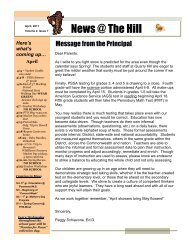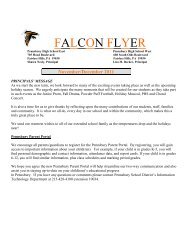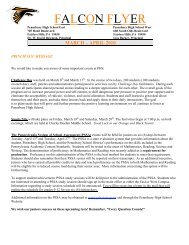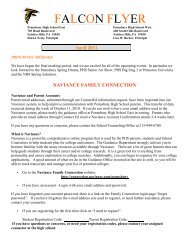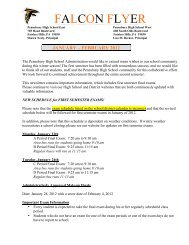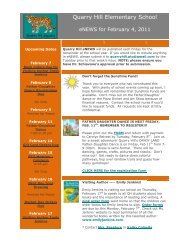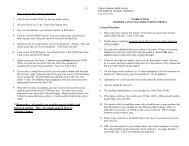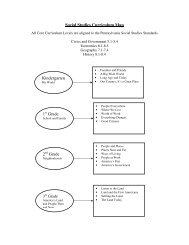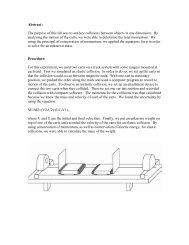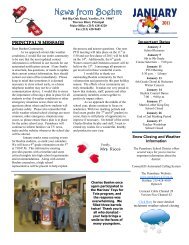Study Guide Environment: Chapter 2 Ecosystems & Biomes? 1 ...
Study Guide Environment: Chapter 2 Ecosystems & Biomes? 1 ...
Study Guide Environment: Chapter 2 Ecosystems & Biomes? 1 ...
You also want an ePaper? Increase the reach of your titles
YUMPU automatically turns print PDFs into web optimized ePapers that Google loves.
<strong>Study</strong> <strong>Guide</strong><br />
<strong>Environment</strong>: <strong>Chapter</strong> 2 <strong>Ecosystems</strong> & <strong>Biomes</strong>?<br />
1. Name and describe the energy roles that organisms play in an ecosystem.<br />
a. Producer, 1rst level consumer, 2 nd level consumer, 3 rd level<br />
consumer, decomposer,<br />
Producer- an organism that can make its own food. Is the<br />
source of all food in an ecosystem.<br />
1rst level consumer- (herbivore)- Eats producers (plants)<br />
2 nd level consumer- eats 1 st level consumers<br />
3 rd level consumer- eats 2 nd level consumers<br />
Decomposer- break down wastes and dead organisms<br />
returning the raw materials to the ecosystem.<br />
b. Explain why there are very few 3 rd level consumers in an ecosystem.<br />
-in an energy pyramid, the most energy is available at the<br />
producer level. As you move up the energy pyramid, about
90% of the energy is lost at each level. In other words,<br />
producers have 100% of the energy. They pass only 10% of<br />
this energy on to the first level consumers which will use 90%<br />
of this energy, passing only 10% on to the 2 nd level consumer.<br />
c. The difference between a carnivore, herbivore, and omnivore.<br />
Carnivore- eat only animals<br />
Herbivores- eat only plants<br />
Omnivores- eat plants and animals.<br />
d. Identify producers and consumers in a diagram.<br />
Producers will be plants and some bacteria.<br />
2. Describe how much energy is available at each level of an energy pyramid.<br />
100% at the producer level which uses 90%, passing only 10% on to<br />
first level consumers, which pass only 10% on to 2 nd level consumers.<br />
Producers=100% of energy<br />
1rst level consumer= get 10% of the energy<br />
2 nd level= get 1% of the energy<br />
3 rd level = get .1% of the energy<br />
3. Name and describe the processes involved in the water cycle
a. Evaporation- The process by which molecules of water gain energy<br />
and change to a gas (water vapor)<br />
b. Condensation- The process by which a gas (water vapor) changes to<br />
a liquid.<br />
c. Precipitation (include examples)- Water falling from the sky.<br />
i. Rain, snow, sleet, hail.<br />
d. Ground water & surface run-off- Ground water is precipitation that<br />
soaks into the ground.<br />
i. Surface run-off- is precipitation that runs along the ground to<br />
local lakes, rivers or streams.<br />
4. Explain how carbon and oxygen are recycled in ecosystems<br />
- Carbon Dioxide (CO2) is taken in by plants which use the Carbon ( C )<br />
to produce carbohydrates and sugars. The plants give off Oxygen<br />
(O2) as their waste product. Animals take in the O2 (Oxygen) and<br />
release CO2 (carbon dioxide). This cycle continues.<br />
a. Define photosynthesis .<br />
- The process in which organisms use water along with sunlight and<br />
carbon dioxide to make their own food.<br />
b. What is released as a result of photosynthesis? Oxygen
5.<br />
a. What do plants use carbon to produce in the process of<br />
photosynthesis<br />
i. Sugars and Carbohydrates (starches)<br />
6. Define and describe the nitrogen cycle.<br />
In the nitrogen cycle, nitrogen moves from the air to the soil, into living<br />
things, and back into the air.<br />
a. Identify the step on a diagram (see p. 52 in text book)<br />
b. What lives in nodules?<br />
-nitrogen fixing bacteria which take free nitrogen and fix it into<br />
nitrogen containing compounds that organisms can use.<br />
7. Explain how the movement of the continents has affected the distribution<br />
of species.<br />
- It has limited the species to certain continents. It has also led to the<br />
discovery of the same species on continents that are far away from<br />
each other. Like tropical plants on a polar continent.<br />
a. Identify physical barriers<br />
- Water, mountains, deserts.
. Exotic species- Species that are carried to a new location by people.<br />
c. Climate- The typical weather pattern in an area over a long period of<br />
time.<br />
d. Continental drift= The very slow motion of the continents.<br />
8. Identify the six major biomes found on earth by their characteristics (temp.,<br />
rainfall, etc.<br />
Rain forest-<br />
Precipitation- greater than 300 cm/year<br />
- Has an abundance of plant life<br />
- Tropical rain forests are found mainly along the equator.<br />
Desert-<br />
Temperature- in temperate rain forest is moderate<br />
-receives less than 25 cm of rain a year.<br />
-evaporation is greater than precipitation<br />
-scorching hot during the day and freezing at night
Grassland-<br />
plants.<br />
-An area that is populated by mostly grasses and other non- woody<br />
- 25-75 cm of rain/year.<br />
-fires and drought are common.<br />
-home to the largest grazing herbivores (elephants, bison, antelopes,<br />
giraffes, kangaroo’s)<br />
Deciduous Forest<br />
- Many of the trees shed their leaves and grow new ones each year.<br />
- Have seasons.<br />
-<br />
Boreal Forest<br />
Colder<br />
- Mainly coniferous trees (pine trees like the fir, spruce and<br />
hemlock)
Tundra<br />
- winters are very cold with lots of snow, and summers are rainy<br />
and warm.<br />
Extremely cold and dry<br />
- receives no more precipitation than a desert.<br />
- plants include mosses, grass, shrubs and dwarf trees.<br />
a. Explain why a large number of plants grow in the tropical rain forest.<br />
The warm temperatures and abundant rainfall lead to lots of<br />
plant growth.




